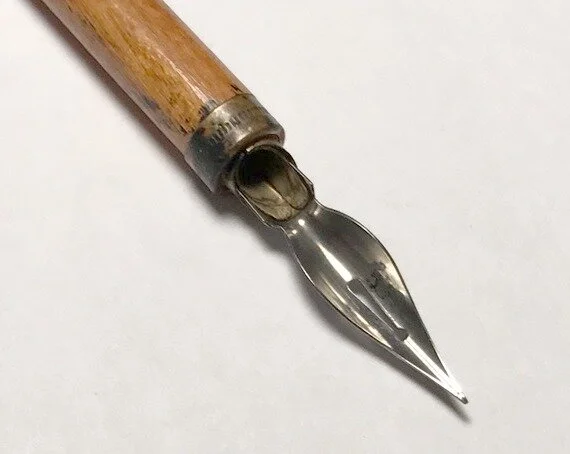Earliest Influences
My first encounters with art that I can remember were comics. The first comic book I remember having was The Amazing Spider-Man #6 (vs The Lizard). I still have the comic but, as you might imagine, it's in terrible condition.
My first comic, The Amazing Spider-Man #6. Art by Steve Ditko
Me heading off to YMCA camp, probably worrying my dad might throw away my comics while I’m gone. (He never did).
My parents were supportive of my liking to draw, but NOT supportive of comic books. There were frequent threats to “Toss them in the trash!” when I wasn't home. Further, my father, who'd been interested in art earlier in his life, was very much an advocate of learning a “real” profession and maybe drawing and painting as a hobby. He was a geologist and couldn't understand why I wasn't captivated by rocks and dirt. (Oddly enough, in the last ten years or so I HAVE become much more interested in geology).
As a teen or preteen though, the only thing about geology that appealed to me were prehistoric creatures.
This leads me to my second artistic influence. Oddly enough, this came from one of my dad's geology books. It was there I saw my first reproductions of paintings by Charles R. Knight (1874-1953).
Left to Right, 1) Edmontosaurus annectens AMNH 2) Triceratops & Tyrannosaurus Field Museum-Chicago 3) Tyrannosaurus & Triceratops family AMNH (American Museum of Natural History) by Charles R. Knight Source; Wikimedia Commons
Smilodon Populator by Charles R. Knight 1903 - American Museum of Natural History. Source; Wikimedia Commons
I can’t say how many hours I spent looking at these and other paintings by the amazing Charles Knight. I guess most kids are fascinated by dinosaurs and I was certainly no exception. Frequent trips to the La Brea Tar Pits added to my interest in his paintings. It also fueled my imagination. It was awesome walking around the actual tar pits, smelling them and closing my eyes and imagining animals becoming trapped, then the saber-toothed tigers coming to prey on them only to become stuck themselves. It was often very hot when we visited, adding to the feel that I was actually in that time.
I often thought that I didn’t really have all that much artistic input growing up. I never took an art class until my last semester of high school. None of my friends were into art. A couple of fellow comic collectors tried sketching a few times, but quickly gave it up when they discovered it was more difficult than they’d thought it would be. I stuck with my drawing efforts longer than my friends but also became discouraged when it became apparent that I didn’t seem to have much natural talent and that drawing was much more difficult than it appeared when I watched someone who could draw fairly well, such as the portrait artists at Disneyland or someone on television.
Jon Gnagy 1907-1981 A self taught artist regarded as America’s first television art instructor.
One of Jon Gnagy’s art kits.
My first art “teacher”
This brings to mind an artist that I watched on tv when I was very young, probably around six or seven, named Jon Gnagy. He had a show called “Learn to Draw with Jon Gnagy” that I believe was on either early Saturday or early Sunday morning. Apparently I was watching re-runs since it originally aired from 1950-1955. I remem-ber watching it and trying to draw along with him, hoping not to wake up my parents who were trying to sleep in.
I still have a pencil with “Jon Gnagy” on the side that came from his “Learn to Draw Kit” that I received from either my parents or grandparents one Christmas.
I recently did a search on the internet and was amazed to see the number of people who loved, and were influenced by him. This includes book illustrators, comic book artists, Disney artists and Andy Warhol. Warhol even stated that he learned to draw from Jon Gnagy, bought all his books and watched all his shows.
I was really astounded to find out how many people watched, and were influenced by this man. I was also pleased to find that his original shows are available for viewing on line at no cost. As I watched them again after so many years i was struck by how they may appear very basic and simplistic, yet he is really teaching, not just how to draw, but how to design pictures. That, along with his obvious joy in teaching is still, to me, quite enjoyable and refreshingly unpretentious.
Here is a link to his site.
https://www.jongnagyart.com/Jon_Gnagy_Art/Jon_Gnagy_Home.html
Illustration for Robin Hood (1917) by N. C. Wyeth. Public Domain image.
N. C. Wyeth (1882-1945)
Book Illustrations
Another source of inspiration I remember from about this time were book illustrations I came across in some books my parents had. My mom had a collection of illustrated books of classics for children which she would sometimes read to us before bed. One of these was “Robin Hood” illustrated by N. C. Wyeth (1882-1945). The incredible illustrations by N. C. Wyeth absolutely amazed me and brought the book to life for me. There were other volumes illustrated by other artists but none, in my mind at the time, could come close to Wyeth.
Illustration for Treasure Island (1911) by N. C. Wyeth. Public Domain image.
Frank Godwin (1889-1959) Treasure Island
Frank Godwin (1889-1959)
The only problem with books illustrated like this was, there weren’t enough illustrations in the books!
I remember wanting to see way more of them. Sometimes you’d read two or three chapters before getting to the next illustration.
This seemed to be leading me inevitably back to
comic books.
Frank Godwin (1889-1959) Treasure Island









